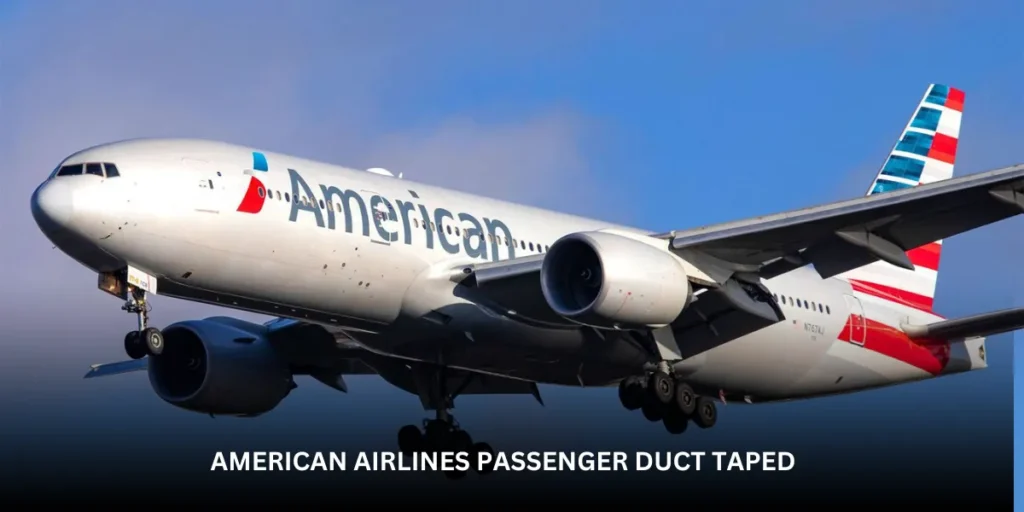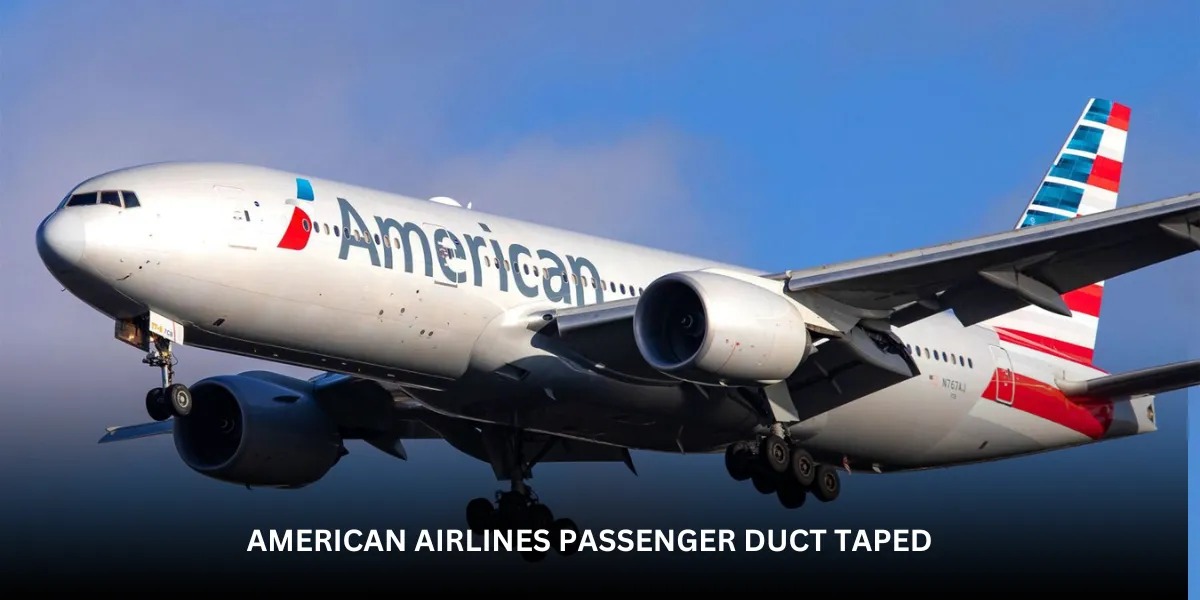american airlines passenger duct taped When flying, we expect the unexpected, but every now and again, things may get very weird. A recent article detailing how an American Airlines passenger who attempted to open the cabin door while traveling was bound to their seat and gagged has gone popular on the internet. This amazing event raises a lot of questions about airline management, passenger behavior, and flight safety. Let’s look at the details of this incident and discuss some broader implications.

1. Introduction to the Incident
Imagine this: Mayhem breaks out all of a sudden while you’re watching a movie or even dozing off on a peaceful flight. This was witnessed personally by passengers on an American Airlines flight when an unusual behavior by one passenger led to an amazing response from the crew. In this article, we look at the particulars of this shocking tragedy, its causes, and its broader consequences for aviation safety..
2. What Exactly Happened?
On a recent American Airlines aircraft, a passenger attempted to open the cabin door. This not only posed a significant risk to other passengers’ safety but also caused anxiety in them. When things got out of control, the crew had to gag the person and bind them with duct tape to prevent further disturbance.
3. The Immediate Response by Crew and Passengers
When the passenger began to act out, the flight attendants quickly assessed the situation and decided to take decisive action. They used duct tape to secure the passenger to their seat. This strategy, albeit unusual, was necessary to ensure the safety of every passenger. Before the plane made an emergency landing, a few passengers assisted in calming things down.
4. Understanding Passenger Behavior
Why would somebody try to unlock a cabin door while in midair? It’s important to understand that this behavior could be the result of a variety of circumstances, including a medical emergency, substance misuse, or psychological distress. Passengers may occasionally act without fully understanding the consequences of their choices, placing them in dangerous situations.
5. Safety Protocols in Aviation
Airlines have strict safety protocols in place to deal with these kinds of incidents. Flight attendants have extensive training so they can manage difficult guests and emergency situations. Restraints are a part of these protocols to ensure the general safety of the crew and passengers, even if they are rarely employed.
6. Legal Ramifications
Attempting to open an airplane door while the aircraft is in flight is prohibited and dangerous. The passenger engaged in this act may face severe legal consequences, including fines and jail time. Because they endanger aviation security, authorities take these kinds of operations very seriously.
7. Public Reactions and Media Coverage
The incident quickly became well-known and sparked a lot of conversation on social media and news websites. Some questioned the crew’s strategy, but others praised their quick thinking and decisiveness. The difficulty of handling emergencies while in flight is highlighted by this contradictory reaction.
8. Comparative Analysis with Past Incidents
An airline has already handled a situation like this. Past mishaps, such as the well-known one with an agitated passenger being restrained on a United Airlines aircraft, may teach the business a lot. By comparing these examples, we may gain a better understanding of the evolution of safety protocols and the importance of preparedness.v
9. Psychological Factors at Play
Understanding the passenger’s mental condition is crucial. Behavior that is unpredictable may be caused by mental health issues such as anxiety, panic attacks, or other illnesses. Airlines are emphasizing mental health awareness and training more and more in order to properly handle such circumstances.
10. How Airlines Train for Such Scenarios
In order to handle any kind of emergency, flight attendants receive intensive training. They have received training on handling rowdy passengers, medical crises, and even possible security risks. Their ability to respond quickly and efficiently in stressful circumstances is ensured by this instruction.
11. The Role of Technology in Enhancing Safety
Modern technology has a big impact on aircraft safety. Because technology offers crews advanced communication systems and real-time monitoring of activities while in flight, it makes handling situations easier for them. These kinds of advancements are crucial for managing and averting tragedies like the one that happened on American Airlines..
12. Future Preventative Measures / american airlines passenger duct taped
In the future, airlines might take additional precautions to prevent these kinds of incidents. This might mean more thorough passenger screening, improved mental health support, and improved training for crew members. Ensuring a safe and secure flying experience for every passenger is the aim of these measures.
13. Conclusion: Learning from the Incident
This incident serves as a stark reminder of how erratic plane travel can be. It highlights the importance of stringent safety laws, in-depth instruction, and the necessity of appropriate passenger behavior. The aviation industry can continue to advance and ensure the safety of all passengers by learning from these kinds of occurrences.
FAQ
Is it possible for a traveler to open a cabin door while in flight?
It is impossible to open a door while in flight due to the pressure differential between the outside and inside of the cabin. Throughout the flight of the airplane, the doors are intended to stay firmly closed.
How can one deal with an unruly passenger legally?
Unbehaveing travelers may be subject to penalties, jail time, and a lifetime ban from the airline. The safety of each and every passenger on board is put in danger by their activities, which are regarded very seriously.
What is the protocol for managing emergencies by flight attendants?
Flight attendants are prepared to deal with a range of crises, such as medical problems, security breaches, and rowdy passengers. To guarantee each visitor’s safety and wellbeing, they adhere to stringent regulations.
What steps can be done to stop such occurrences from happening again?
Improved crew member training, expanded mental health services, improved passenger screening, and the use of cutting-edge technology to monitor activities during flight are examples of preventive approaches.

